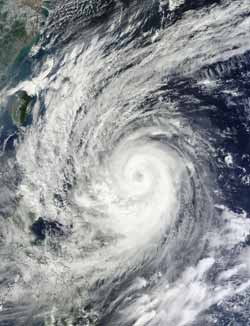NASA Sees Typhoon Prapiroon Doing a "Sit and Spin" in the Philippine Sea

NASA's Terra satellite passed over Typhoon Prapiroon on Oct. 11 at 0210 UTC (1010 p.m. EDT, Oct. 10) and captured a visible image of the storm while it was in the Philippine Sea. Credit: NASA Goddard MODIS Rapid Response Team<br>
NASA's Terra satellite passed over Typhoon Prapiroon on Oct. 11 at 0210 UTC (1010 p.m. EDT, Oct. 10) and the Moderate Resolution Imaging Spectroradiometer (MODIS) instrument captured a visible image of the storm. The visible imagery clearly showed a small ragged eye, and microwave satellite imagery confirmed the eye. Satellite imagery also confirmed a well-defined low-level center of circulation.
By 11 a.m. EDT on Oct. 11, Prapiroon's maximum sustained winds were near 95 knots. It was located about 415 nautical miles south of Kadena Air Base, Okinawa, Japan, near 19.4 North and 128.5 East and not moving.
The storm slowed to a quasi-stationary position between two ridges (elongated areas) of high pressure. Prapiroon is expected to get a jump start again and get most of its steering influenced by the ridge located the east of the storm.
According to the forecasters at the Joint Typhoon Warning Center, between [12 and 24 hours from 11 a.m. EDT on Oct 11] Prapiroon is expected to Slowly re-curve around the western extent of the subtropical ridge and take on a northeastward track over the next three days.
Text credit: Rob Gutro
NASA's Goddard Space Flight Center, Greenbelt, Md.
Media Contact
All latest news from the category: Earth Sciences
Earth Sciences (also referred to as Geosciences), which deals with basic issues surrounding our planet, plays a vital role in the area of energy and raw materials supply.
Earth Sciences comprises subjects such as geology, geography, geological informatics, paleontology, mineralogy, petrography, crystallography, geophysics, geodesy, glaciology, cartography, photogrammetry, meteorology and seismology, early-warning systems, earthquake research and polar research.
Newest articles

High-energy-density aqueous battery based on halogen multi-electron transfer
Traditional non-aqueous lithium-ion batteries have a high energy density, but their safety is compromised due to the flammable organic electrolytes they utilize. Aqueous batteries use water as the solvent for…

First-ever combined heart pump and pig kidney transplant
…gives new hope to patient with terminal illness. Surgeons at NYU Langone Health performed the first-ever combined mechanical heart pump and gene-edited pig kidney transplant surgery in a 54-year-old woman…

Biophysics: Testing how well biomarkers work
LMU researchers have developed a method to determine how reliably target proteins can be labeled using super-resolution fluorescence microscopy. Modern microscopy techniques make it possible to examine the inner workings…





















